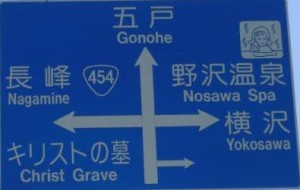Jesus Lived to 114 in Japan! January 11, 2012
Author: Beach Combing | in : Ancient, Contemporary , trackbackBeach has long been hearing rumours that Jesus Christ was actually buried in an obscure Japanese village of Shingo. But it was only this morning that he finally decided to climb up this particular mountain of madness and see what was really happening up in the mists.
According to local ‘tradition’ (always a slippery word) Jesus spent his missing years in Japan (12-30) and then, when about to be crucified ran Nipponwards again. As a BBC reporter summed it up.
His place was taken by one of his brothers, who for some reason is now buried by his side in Japan. The story goes that after escaping Jerusalem, Jesus made his way across Russia and Siberia to Aomori in the far north of Japan where he became a rice farmer, married, had a family and died peacefully at the age of 114.
His family live there to this day in the area and babies in Shingo are traditionally marked with a cross on the forehead. The proof the ages have been looking for… You can also lay flowers on Christ’s tomb.
So where did this particular cargo-cult nonsense wash up from? Beach here would like to know more: drbeachcombing AT yahoo DOT com But this is what he has dug up so far.
In 1935 a local Shinto priest Kyomaro Takeuchi, discovered a series of documents: the Takenouchi Documents, written by Jesus himself. These documents were so controversial that the Japanese government seized control of them and stored them away in a Tokyo museum: remember that final scene in the first Indiana Jones film…
Here they were destroyed by the godless Americans in an air-raid, and we now rely on modern copies. It would be interesting to see the chain of custody.
In any case, these now lost documents were written by Christ’s own hand – naturally in modern Japanese, rather than whatever nonsense the locals spoke 2000 years ago (there was no Japanese spoken then). They explain not just Jesus’s biographical irregularities but also many secrets about the history of the world. They also, go figure, strangely echo the nationalist fervour of Japan in the 1930s.
Beach here would send readers to their leading modern interpreter, a very amiable Japanese chiropractor. Headings include such giveaways as: WHY IS JAPAN THE CENTER OF THE WORLD? THE ORIGIN OF MAYAN CIVILIZATION WAS ALSO JAPAN and AMERICAN INDIANS USED THE JAPANESE LANGUAGE! Though, let the record state that the music is by far the best Beach has ever heard online.
Beach particularly enjoyed the author’s discovery, while giving a British patient chiropractic treatment in Kent, that there was an ancient airfield immediately through the bay windows: apparently the name Herne corresponds to a similar Japanese word Hane and the soil was remarkably dense.
For the past five hundred years the West have projected their anxieties and questionable spirituality on other parts of the world: Tibetan tea anyone? There is something rather humbling then in seeing a field of Kentish beets becoming central to a Japanese visitor’s spirit quest.
***
22/1/2012: KMH writes in a comparative key: ‘To rise above the written revelation of Moses, Christianity had to appeal to the truth itself. Therefore, nothing in writing can be definitive for Christianity just because it has been written. This is one reason there are so many formal mysteries associated with the religion. The most that can be said for the Japanese claim is that it might be a work of an early Christian who had some inspiration about the life of Christ and made it to Japan. There are plenty of apocryphal works concerning early Christianity. These unsupported documents and traditions around the world evidently exist to provide some basis for Christianity in deeply-rooted cultures naturally opposed or oblivious to the religion. It is widely accepted that Thomas, one of the 12 apostles made it to India. Of course, there are claims that Christ, Solomon, and Moses are actually buried near that region. Also, a document discovered by a Russian claims Christ visited Tibet. The whole topic of these interesting claims (including Christ visiting England and Ethiopia) would make for a good book. You might thoroughly enjoy it.’ Thanks KMH!



